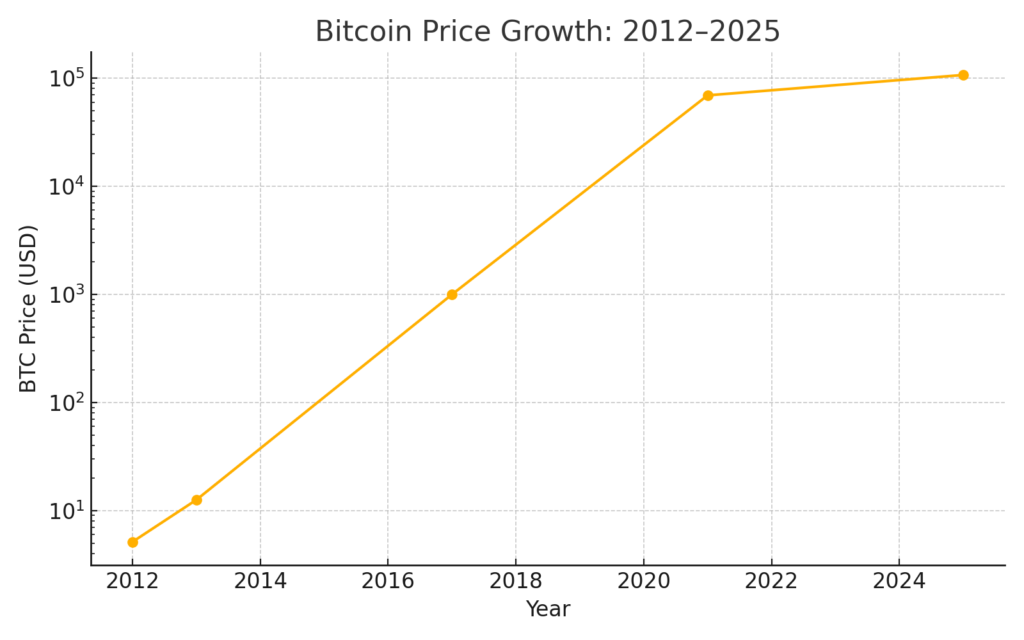
Main Points:
- Remarkable ROI: A 2012 Casascius bar containing 100 BTC, bought for $500, redeemed for over $10 million in July 2025—a ~2,000,000% return
- Casascius Legacy: Physical bitcoins by Mike Caldwell, minted 2011–2013, halted by FinCEN ruling; embedded holograms conceal private keys
- Redemption Challenges: “John Galt” wrestled with trust, auction obstacles, and even lost ~ $40,000 BCH due to a key-exposure error
- Bitcoin’s Price Evolution: From ~$5 in early 2012 to ~$107,000 in mid-2025—an unprecedented bull run seen on the chart below
- Collectible Market: Over 10,000 Casascius bars redeemed, 18,000+ still dormant; collector appetite and secondary market premiums rising
- Investor Takeaways: Physical crypto can be both storied collectibles and complex liabilities; diversification, custody best practices, and emerging asset classes offer new opportunities
- Broader Crypto Trends: Institutional flows into spot ETFs, looming halving cycles, and adoption by treasuries underscore Bitcoin’s maturing landscape
1. A Windfall Unlocked: The $10 Million Redemption
In July 2025, a long-time Bitcoin aficionado known as “John Galt” finally peeled back the hologram on a 100 BTC Casascius bar he purchased in 2012 for just $500. When Bitcoin soared past $100,000, he redeemed the embedded key—realizing a windfall north of $10 million and a jaw-dropping return of nearly 2,000,000% on his original outlay. His story captivated the crypto community, illustrating both the power of HODL and the allure of physical bitcoin collectibles.
2. The Casascius Phenomenon: Tangible Bitcoin History
Mike Caldwell launched the Casascius line in 2011, producing coins and bars with values ranging from 0.1 BTC up to 1,000 BTC. Each piece housed a private key under a tamper-evident hologram, linking physical form to digital value. By 2013, FinCEN deemed Caldwell’s operations a money-transmission service, forcing him to cease production. Despite this regulatory intervention, Casascius collectibles have only gained in monetary and historical significance, traded on secondary markets as artifacts of crypto’s early days.
3. Trials of Redemption: Trust, Technicalities, and BCH Pitfalls
John Galt’s decision to redeem was fraught with anxiety. He attempted private sales and even explored auctions but feared settlement below the true BTC value. Ultimately, he sacrificed the bar’s collectible mystique to access its digital treasure. His redemption process involved:
- Key Extraction: Peeling the hologram to reveal the mini private key.
- Wallet Sweep: Initial missteps with Electrum Android led him to use bitaddress.org for key conversion.
- BCH Loss: A photo of the exposed key allowed a stranger to sweep unclaimed Bitcoin Cash, costing him ~$40,000.
This saga underscores the perils of physical crypto custody—where a single misjudgment can have costly ramifications.
4. Charting Bitcoin’s Meteoric Rise
Bitcoin’s journey from niche experiment to global store of value is starkly visible in its price history. The chart below highlights key milestones:
- Jan 1, 2012: $5.13 (closing price)
- End 2012: ~$12.56 (yearly rally)
- Dec 2017: ~$998—a prelude to the first major mainstream surge
- Nov 2021: ~$69,300 (all-time high at the time)
- June 2025: Closed above $107,000—the trigger for Galt’s redemption

(Chart displayed above)
5. The Physical Crypto Collector’s Market
Casascius bars exemplify crypto collectibles, blending numismatic and digital value. According to tracking data, over 10,000 pieces have been redeemed, while 18,000+ remain in dormant wallets, hinting at potential future unlocks. Premiums on secondary markets often exceed intrinsic BTC value, driven by scarcity, historical pedigree, and collector demand. For investors, these dynamics illustrate how tangible assets can complement digital portfolios—but also carry unique liquidity and custody challenges.
6. Lessons for Crypto Investors
- Diversification: Physical collectibles can amplify gains but introduce single-point custody risk.
- Custody Best Practices: Use multisig wallets, offline key storage, and avoid public exposure of private keys.
- Emerging Asset Classes: Explore tokenized real-world assets, NFTs, and DeFi instruments for novel revenue streams.
- Due Diligence: Research provenance and regulatory history before acquiring rare collectibles.
7. Wider Crypto Market Trends
The Casascius redemption occurs amid broader institutional adoption: spot Bitcoin ETFs have amassed billions in inflows, corporate treasuries are doubling down on BTC, and strategists predict continued bullish momentum toward $115,000–$150,000 by year-end. With the next Bitcoin halving on the horizon, scarcity dynamics may further fuel price action, reinforcing Bitcoin’s narrative as “digital gold.”
8. Looking Ahead
As Galt’s story reminds us, patience in crypto can yield extraordinary rewards—but not without risk. The physical-digital nexus of Casascius bars will continue to fascinate collectors, even as digital custody practices evolve. For investors scouting new revenue sources or practical blockchain uses, the takeaway is clear: understand asset particulars, manage custody rigorously, and maintain a long-term horizon.

